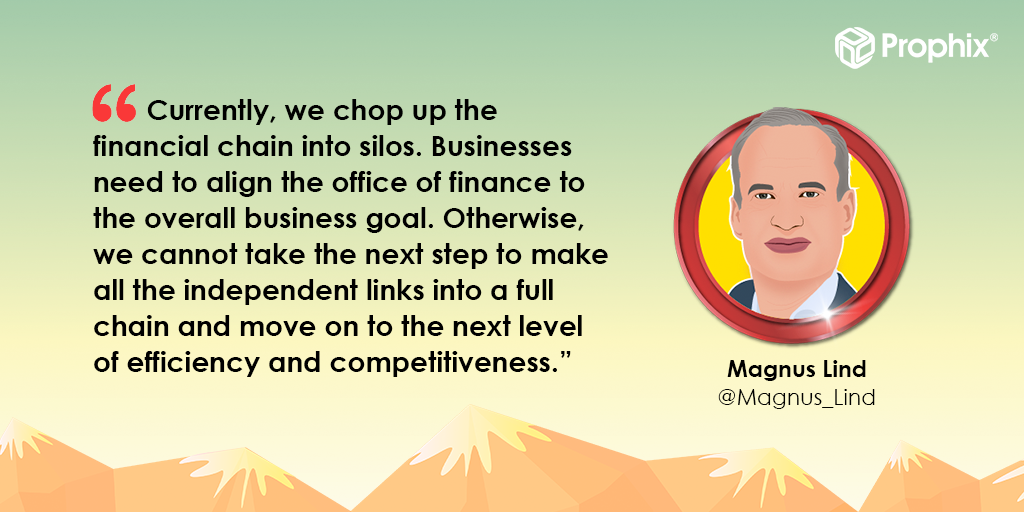The future of finance depends on managing data. That means breaking down silos, investing in the proper technology and processes, and optimizing the data flow through the finance department out to the rest of the business. When CFOs and FP&A leaders master data, they will be able to innovate, grow the business, and turn the finance department into a true profit center.
In his book Finance Unleashed: Leveraging the CFO for Innovation, Magnus Lind addresses the specific challenges that can throttle the flow of data and stifle innovation. According to Lind, maximizing the potential of the CFO role — and the finance department in general — requires a perspective change. Finance professionals need to take a holistic view of the company, taking into account the entire financial supply chain, rather than focusing on internal reporting.
We sat down with Mr. Lind to find out why the “outside in” perspective is so important, and how finance departments can begin the transformation. Here’s what he had to say.
Prophix: The idea of an “outside in” perspective is a foundational element for your book. Can you explain the difference between “inside out” and “outside in” for finance?
Lind: Historically, the CFO and all finance executives have had an “inside out” perspective. That means they’re focused on the internal workings of the business. They take care of compliance, reporting, liquidity, etc. That’s been the role of the CFO for a long period of time.
Those with an outside perspective — for instance, sales, business development, product development, CEO and the board — are tasked with growing the company. “How do we get new customer segments, how do we support the customers?”
CFOs usually don’t have that outside in perspective. And that’s by design: they were hired to compensate for the blind spots in the sales and business development departments.
That lack of outside in perspective, that ability to see the bigger picture, does put financial processes at a disadvantage, though.

Prophix: Why do businesses find it so challenging to optimize and improve financial processes? Why is finance still lagging behind?
Lind: Businesses have been improving the physical supply chain for the past 40-50 years, while the financial supply chain has evolved much more slowly. For example, it takes 18 hours to manufacture a car. An entire vehicle that will work for 10-15 years, 18 hours to make. But to process the payment, it takes 48 hours. So there is this discrepancy between what we call the financial supply chain and the physical supply chain.
One of the issues has been that in the physical supply chain, we have been leveraging Lean and Six Sigma, completely different ways of looking at processes, since the 50s and 60s. We have optimized the whole supply chain to improve the flow of goods, but the financial chain has been a residual.
We have developed the physical supply from a chain perspective. From the customer viewpoint it’s just one company, but the supply can involve 20 smaller companies, 20 separate legal entities. They’re all participating, saying, “If you do this part it’s cheaper, if we do this part, it’s cheaper and higher quality.” So we have reduced the price, raised the quality and reduced the time to develop and deliver the product.
This optimization has not happened in the financial chain. So if you look at a financial chain with 20 legal entities, you can lose two to five percent in each step, just in transfer of ownership and payments. That becomes a huge cost for the customers. If the customer knew how much money the supply chain was spending on payments, they would be furious!
No one’s looking at the entire process as a whole. This inside-out, siloed perspective causes inefficiencies across the board. For example, every company looks to pay suppliers as late as possible and collect payments as early as possible. This has created a situation where large companies hoard cash and invest it for, say, one percent in the capital markets. Then they pay suppliers late, and suppliers pay 7-10 percent in interest. It’s inefficient, increases financial costs and introduces lags into the timeline.
These inefficiencies and waste are a huge part of the price, which damages a company’s competitiveness in the marketplace.
Prophix: Should the finance department be responsible for developing this financial supply chain?
Lind: So the CFO had previously had the role of seeing how we have improved the physical chain. Now suddenly the CFO is in the driver’s seat to change and improve the financial chain.
[bctt tweet=”“Now, the CFO is in the driver’s seat to change and improve the financial chain.” says @Magnus_Lind” username=”prophix”]Of course, the CFO has to continue to have an inside-out perspective to control compliance, do reporting and all that. But also they have to join the other parties in the outside in perspective to shape the financial chain and apply the same Lean Six Sigma learnings we used for the physical chain.
Prophix: Finance Unleashed talks about customer-centricity, which has historically not been the finance department’s function. How does taking a customer-centered view change the way we approach finance?
Lind: Inside the CFO office, there are contradicting targets that are suboptimal for the whole chain and the company. You have to enlighten everyone to look at the chain from a customer perspective. You have, for instance, a treasury function that is aiming to reduce the working capital, which basically means pushing payment terms. Whereas procurement is trying to take down the cost, the price from supplies and what you have to pay early.
The way to align the CFO office is to get everyone in and say, “Okay, I’m not doing this report, I’m prioritizing this thing that is sensible from a customer’s perspective.” So you have to be able to approach and improve a supply chain from a customer perspective, the KPIs have to be realigned to a customer perspective. This is a huge change for the CFO office.
When you have done that, you can take the next step take a supply chain perspective on the financial flow. You can apply Lean Six Sigma, do the same kind of work we’ve been doing in the physical chain for many years. When that’s done you have an overview, a good chain perspective, good cooperation in our system.
We call it an ecosystem play instead of an ecosystem fight. We’re pushing payment terms and cost upside down compared to the financials of supply and demand that we do now. We take a holistic view on supply and see how can we get the financial cost down.
Prophix: How does optimizing the financial supply chain open up possibilities for innovation?
In the book, we have interviewed nine people, CFOs, CPOs, consultants, even a governor from the central bank, to give their perspective of how this can be done. We have case studies from U.P.S. and DHL, how their CFOs have been working to introduce financial products to their offering increase profitability, growth and value for customers.
For example, we worked with Turkcell, the biggest cellular operator in Turkey. Their CFO introduced a customer finance offering, because when the CFO took a financial supply perspective he saw that what they are really good at besides communications is lending money. Now they can lend money to 35 million devices. That innovation is how they protect their business from being disrupted.
If you don’t get your financial supply chain under control, the risk is that your whole supply chain will be disrupted. It’s not enough working with improving the physical chain, but also the financial chain. And now the financial chain is in the control of the CFO. That forces the CFO to take a business process role.
[bctt tweet=”“If you don’t get your financial supply chain under control, the risk is that your whole supply chain will be disrupted.” says @Magnus_Lind” username=”prophix”]Prophix: How does data management tie into managing the financial supply chain?
Lind: It’s interesting, because finance is data. It’s almost nothing else. Cash, bills, checks are all phasing out. More and more, it’s just data.
So of course since it’s data, IT is paramount. But when you look at how the ERP enterprise systems were developed, it started with “how can we automate the processing of physical checks?” These systems are more sophisticated now, but that was the start.
Now the financial transaction is a residual. So we need to focus on how we can transform that process thinking or that way of developing software. We need software that can support the financial supply chain in the way that the ERP system supports the physical chain.
What we need is more transparency in the chain of where money is. You can do this in the physical chain. You can see in each moment where each piece of iron ore is, each individual rubber tire. We know where it is, when it’s on its way, in real time.
In the financial chain, we have no clue where the donor is, we have no clue how much we are lending in the supply chain at this moment in time, no clue how many guarantees, no clue in a holistic way, what the risks are. There’s no transparency.
Prophix: What would the ideal data solution look like?
Lind: We need to have ERP that actually looks at the financial chain not as a residual, but as a chain. And then in order to get transparency we have to get away from relying on credit scores from institutions and banks; we have to rely on an ecosystem trust model.
I think we have a long way to go in the IT environment to create this ecosystem play instead of the ecosystem fight that we have now. But I do think in the near future the corporate sector will rely on banks less and less. If we can make the financial chain transparent, see what the costs really are and how we can reduce them, the corporate sector is rich enough to support themselves.
If you look in the supply chain, there’s enough money. Right now the corporate sector has so much working capital starvation, and there’s so many unnecessary fees, there’s so much unnecessary time and friction in the financial chain that we can erase. I mean, the financial chain is in the same shape as the physical chain was 50 years ago.
Magnus Lind is the author of Finance Unleashed and CEO & Founder of Skanor Group. You can follow him on LinkedIn and Twitter.
For more from Magnus Lind and 14 other FP&A experts, check out our interactive quiz: (click the image)







